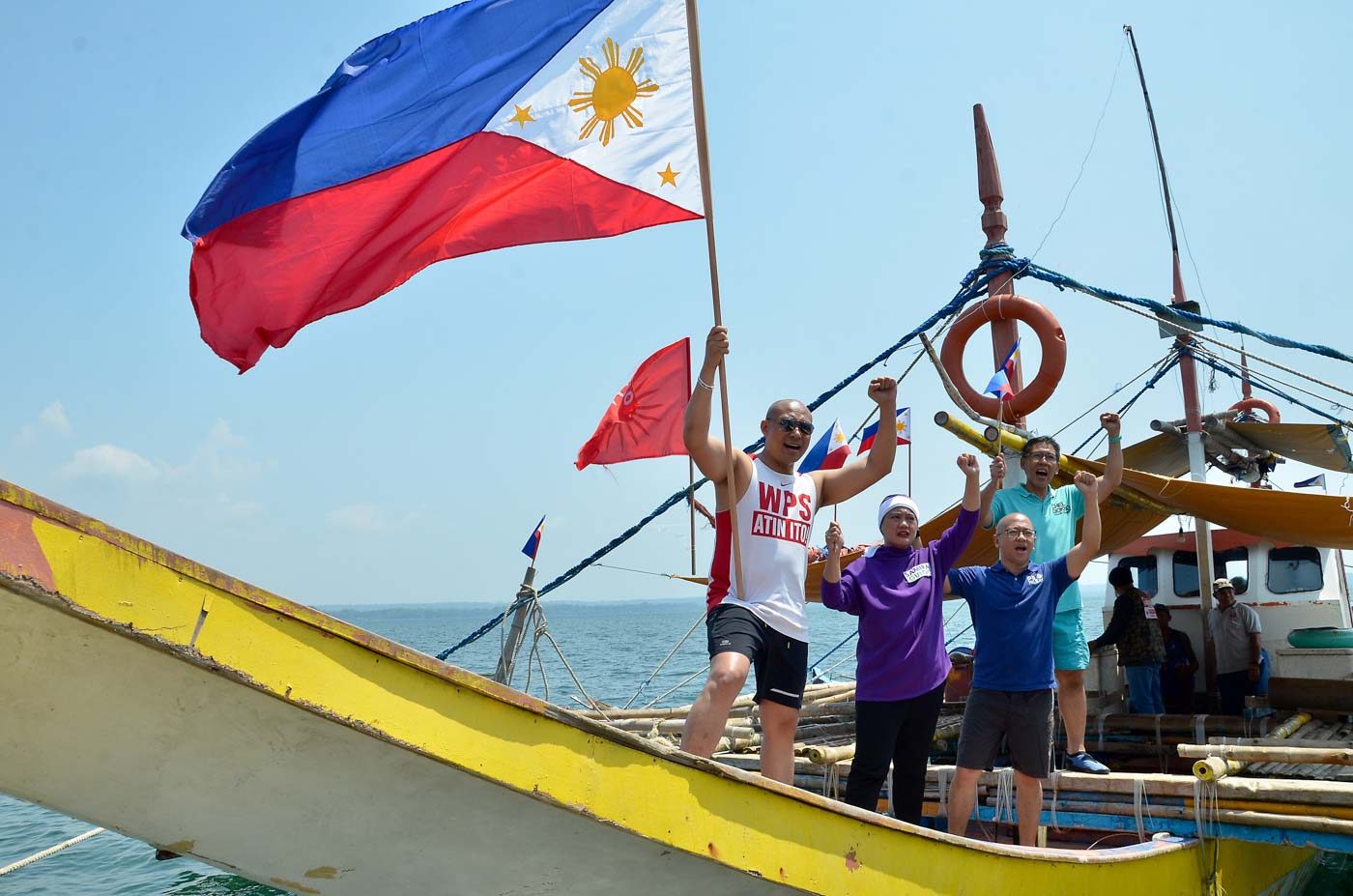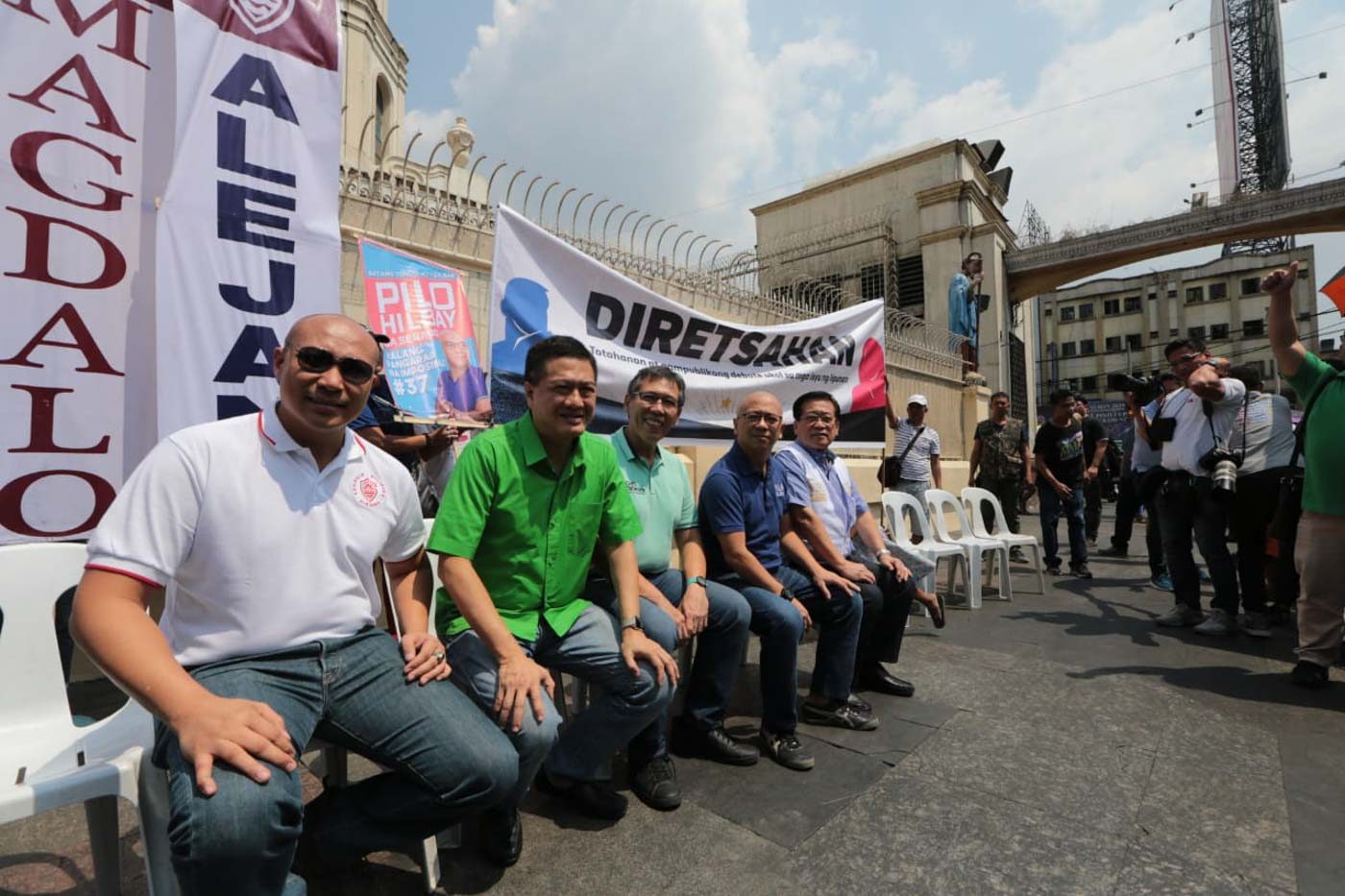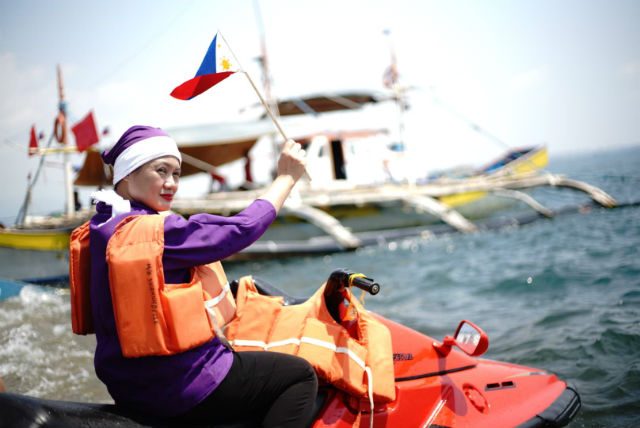SUMMARY
This is AI generated summarization, which may have errors. For context, always refer to the full article.

MANILA, Philippines – The sleepy town of Masinloc, Zambales was a flurry of activity late morning of April 8. Cameras clicked away as a small crowd headed towards the sea and waved flags of the Philippines. Leading the pack were 4 Otso Diretso senatorial candidates still trailing in the pre-election surveys: Gary Alejano, Chel Diokno, Samira Gutoc, and Florin Hilbay.
Miles away, the Chinese Coast Guard still occupies Panatag Shoal in the West Philippine Sea, a part of the South China Sea that belongs to the Philippines, but which China is claiming as its own.
“WPS (West Philippine Sea), atin ito (this is ours)!” cried the senatorial bets flanked by some of their supporters.
The Otso Diretso candidates then posed beside a jet ski parked at the pier to challenge President Rodrigo Duterte, asking him to fulfill his campaign promise to ride the watercraft to parts of Philippine territory with a Chinese presence.
They later boarded a fishing boat – which remained anchored on the pier – and raised the Philippine flag once more. Alejano and Diokno even took a dip in the water.
The next day, Presidential Spokesperson Salvador Panelo quickly dismissed Otso Diretso’s Masinloc visit as “childish gimmickry” and “cheap political propaganda” designed to get media mileage for the slate as they “lambast” Duterte’s foreign policy.
It did not help that the President’s supporters found reasons to nitpick the visit, including Gutoc’s obvious mistake of wearing her life vest backwards.
This is not the first time Otso Diretso has resorted to publicity stunts in the 2019 elections. There was Otso Diretso’s debate challenge against their opponents under the Hugpong ng Pagbabago (HNP) slate at the historic Plaza Miranda on February 25, a date deliberately chosen as it was also the 33rd anniversary of the EDSA People Power Revolution.
Under the intense heat of the sun, 5 candidates of Otso Diretso – Alejano, Diokno, Hilbay, Romy Macalintal, and Erin Tañada – sat beside 4 empty chairs to show the administration bets were “too afraid” to face off with them. (READ: Hugpong bets no-show at Otso Diretso debate challenge)
As in the Masinloc visit, an administration ally fired a comeback against Otso Diretso – presidential daughter and Davao City Mayor Sara Duterte Carpio said the candidates endorsed by her regional party are willing to debate with Otso Diretso, but not “palengke style.”
Buzz for a vote
Should political publicity stunts be frowned upon then? The quick answer is no. The campaign period, after all, is a time when candidates are literally given the chance to make themselves stand out among the scores of other people running for the same seats.
“The objective is to create buzz or talk about the issue in the hope to gain votes,” said Severino Sarmenta, a former two-term chair of the Communication Department of the Ateneo de Manila University on the goal of political publicity stunts.
“Publicity attempts are all around during the campaign, from the time the candidate submits a certificate of candidacy to the campaign trail and all the way to the time he or she casts his or her vote. For example, United States presidential candidates often launch their bids against strong historical landmarks or backgrounds,” said Sarmenta, who was a practitioner and a professor in the fields of public relations and corporate communications for 3 decades.
But for political publicity stunts to work their magic, they have to be done right. Meaning, they should not only lead to headlines about the candidates, but the stunts must also convince more people to vote for the senatorial aspirants in May.
The latter is what Otso Diretso is still struggling to achieve. (READ: Otso Diretso plays catch-up on campaign trail)
Jump for awareness
As far as raising voters’ awareness of Otso Diretso is concerned, their publicity stunts worked in their favor.
Sarmenta said a publicity stunt can be deemed a success if it achieves 3 things:
- it gained mileage online and in traditional media formats
- the public talked about the issue, whether online or offline
- the stunt’s targeted candidates “find it difficult to deny the accusation or are unable to counter the issues raised by the ruse”
News reports were written and aired about the debate challenge and the Masinloc visit of Otso Diretso, as well as the administration officials’ and candidates’ responses to these events. Social media users shared their thoughts supporting – and opposing – the publicity stunts.
“These publicity efforts are commendable given the disadvantage the Otso Diretso line-up has. The strongest and arguably most appealing for the news outlets was the Masinloc visit because there was a strong visual (the jet ski) and it came at a time where there wasn’t much news going along with the story,” said Sarmenta.

Otso Diretso’s challenge against HNP at Plaza Miranda also allowed the opposition bets to brand themselves as the ones brave enough to join debates. And rightly so, as all Otso Diretso candidates have participated in several debates organized by news organizations and the academe in the past weeks.
In contrast, administration bets have long been criticized for avoiding debates just because their survey numbers are already high. (READ: [EDITORIAL] #AnimatED: Candidates avoid debates to avoid scrutiny)
These may help explain why the awareness ratings of the Otso Diretso candidates who participated in the publicity stunts rose in the past 3 months. (READ: ‘Mahaba pa ang laban’: Survey laggard Otso Diretso bets still positive)
A turnoff in the end
But one thing is glaring: even with the publicity stunts, there has been minimal movement in the Otso Diretso bets’ voter preference ratings – the numbers that will play a bigger role come election day. The coveted spots in the so-called winners’ circle in the pre-election polls are still not within grasp of most of the Otso Diretso candidates.
Why? The publicity stunts were mostly geared towards the slate, but did not necessarily make the candidates shine individually.
“What’s always bothering me about Otso Diretso’s campaign is that ‘Otso Diretso’ is not in the ballot box. So it can be at the expense of the individuals,” former Ateneo School of Government dean Tony La Viña told Rappler.
“They need to actually get out of there. In stunts like these, the individuals disappear behind the brand. But the people don’t vote for the brand,” said La Viña.
As an example, La Viña explained that when news outlets wrote about the Masinloc visit, the candidates were still lumped together as one slate that went there. He said Gutoc was highlighted, but only because she committed a faux pas using her life vest.
“In both cases, the candidates disappeared except about the negative thing about Samira getting called out over her life vest. But that’s okay, at least the media talked about her even more, right? Otherwise it’s just Otso Diretso,” said La Viña in Filipino.

As for the debate challenge, its impact was limited because the Philippines has yet to embrace a culture of debate when it comes to politics. University of the Philippines political science assistant professor Jean Encinas Franco said this is why branding yourself as the candidate who willingly debates can only boost your campaign up to a certain extent.
“Media networks and some schools are really trying to sort of inculcate a culture of debate for the campaign. But it has not yet seeped into the Filipino psyche, kaya walang talo kung hindi makikipag-debate (so you won’t lose anything if you don’t join debates),” Franco told Rappler.
“Why would you agree to a debate when you are already having high survey ratings?…Why rock the boat when you already have high numbers and you have resources to create good political ads, which you have control of in terms of what questions will be asked?” she added.
For Franco, the challenge facing Otso Diretso in the last two weeks of the campaign is for them to find a way to “move the people’s collective imagination,” whether it be through another publicity stunt or through their usual door-to-door campaigning.
But it’s a race against time, a fight made even more difficult when Otso Diretso has “reluctant” supporters who got turned off by the Masinloc publicity stunt, like 25-year-old Manuel Angulo.
“That same fixation on the jet ski remark made by the President before and used by the Otso Diretso shows me, as a voter, that their positioning as an opposition is as an opposition relegated only to President Duterte and not to the longstanding political issues and exclusionary economic landscape that had brought President Duterte to power. It is a short-sighted opposition and this became more apparent through the stunt,” said Angulo.
“As a voter looking for an alternative not only to the man but to the present situation, this had failed to meet what I had hoped to see from an opposition. It was petty, it did not give me and perhaps other voters anything to be excited about should these people come to power,” he added.
Can Otso Diretso change his and others’ minds? – Rappler.com
Photo of Otso Diretso beside the jet ski in Masinloc taken on April 8, 2019 by Ben Nabong/Rappler
Add a comment
How does this make you feel?
There are no comments yet. Add your comment to start the conversation.